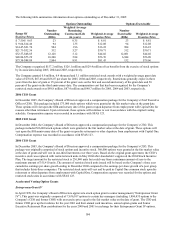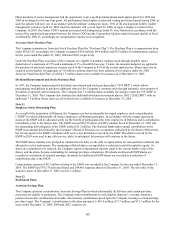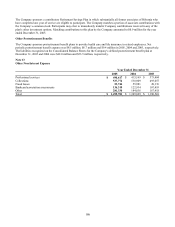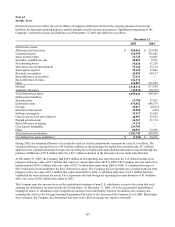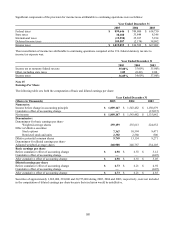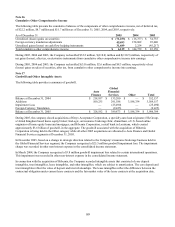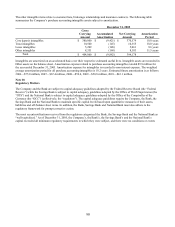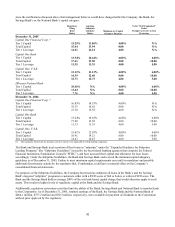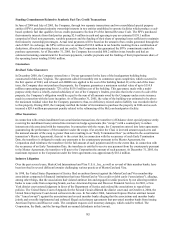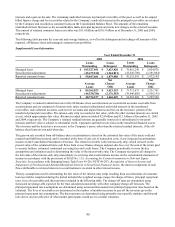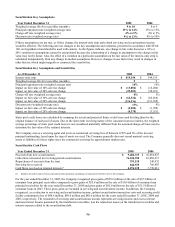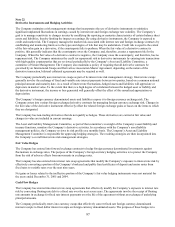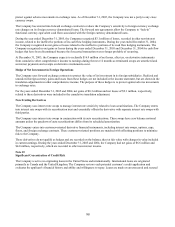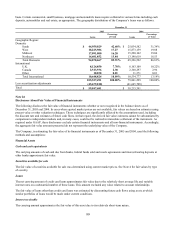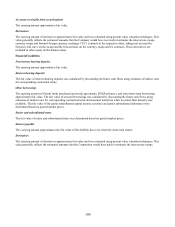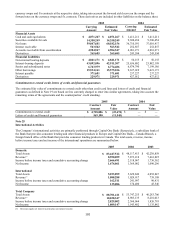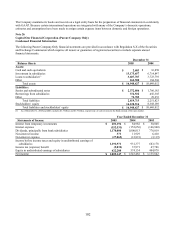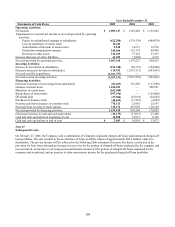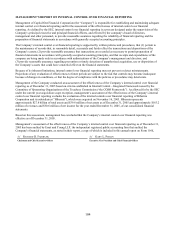Capital One 2005 Annual Report Download - page 103
Download and view the complete annual report
Please find page 103 of the 2005 Capital One annual report below. You can navigate through the pages in the report by either clicking on the pages listed below, or by using the keyword search tool below to find specific information within the annual report.Separately, a number of entities, each purporting to represent a class of retail merchants, have also filed antitrust lawsuits (the
“Interchange lawsuits”) against the associations and several member banks, including the Corporation and its subsidiaries,
alleging among other things, that the associations and member banks conspired to fix the level of interchange fees. The
complaints request civil monetary damages, which could be trebled. In October 2005, the Interchange lawsuits were
onsolidated before the United States District Court for the Eastern District of New York. c
We believe that we have meritorious defenses with respect to these cases and intend to defend these cases vigorously. At the
present time, management is not in a position to determine whether the resolution of these cases will have a material adverse
effect on either the consolidated financial position of the Corporation or the Corporation’ s results of operations in any future
reporting period.
In addition, several merchants filed class action antitrust lawsuits, which were subsequently consolidated, against the
associations relating to certain debit card products. In April 2003, the associations agreed to settle the lawsuit in exchange for
payments to plaintiffs and for changes in policies and interchange rates for debit cards. Certain merchant plaintiffs have opted
out of the settlements and have commenced separate lawsuits. Additionally, consumer class action lawsuits with claims
mirroring the merchants’ allegations have been filed in several courts. Finally, the associations, as well as certain member
banks, continue to face additional lawsuits regarding policies, practices, products and fees.
With the exception of the Interchange lawsuits and the Amex lawsuit, the Corporation and its subsidiaries are not parties to
the lawsuits against the associations described above and therefore will not be directly liable for any amount related to any
possible or known settlements of such lawsuits. However, the Corporation’ s subsidiary banks are member banks of
MasterCard and Visa and thus may be affected by settlements or lawsuits relating to these issues, including changes in
interchange payments. In addition, it is possible that the scope of these lawsuits may expand and that other member banks,
including the Corporation’ s subsidiary banks, may be brought into the lawsuits or future lawsuits. The associations are also
subject to additional litigation, including suits regarding foreign exchange fees. As a result of such litigation, the associations
are expected to continue to evolve as corporate entities, including by changing their governance structures, as previously
announced by the associations.
Given the complexity of the issues raised by these lawsuits and the uncertainty regarding: (i) the outcome of these suits,
(ii) the likelihood and amount of any possible judgments, (iii) the likelihood, amount and validity of any claim against the
associations’ member banks, including the banks and the Corporation, and (iv) changes in industry structure that may result
from the suits and (v) the effects of these suits, in turn, on competition in the industry, member banks, and interchange and
association fees, we cannot determine at this time the long-term effects of these suits on us.
Other Pending and Threatened Litigation
In addition, the Company also commonly is subject to various pending and threatened legal actions relating to the conduct of
its normal business activities. In the opinion of management, the ultimate aggregate liability, if any, arising out of any such
pending or threatened legal actions will not be material to the consolidated financial position or results of operations of the
Company.
Tax issues for years 1995-1999 are pending in the U.S. Tax court. The ultimate resolution of these issues is not expected to
ave a materially adverse effect upon the Corporation’ s operations or financial condition. h
Note 20
Related Party Transactions
In the ordinary course of business, executive officers and directors of the Company may have consumer loans issued by the
Company. Pursuant to the Company’ s policy, such loans are issued on the same terms as those prevailing at the time for
comparable loans to unrelated persons and do not involve more than the normal risk of collectibility.
Note 21
Off-Balance Sheet Securitizations
Off-balance sheet securitizations involve the transfer of pools of consumer loan receivables by the Company to one or more
third-party trusts or qualified special purpose entities in transactions that are accounted for as sales in accordance with SFAS
140. Certain undivided interests in the pool of consumer loan receivables are sold to investors as asset-backed securities in
public underwritten offerings or private placement transactions. The proceeds from off-balance sheet securitizations are
distributed by the trusts to the Company as consideration for the consumer loan receivables transferred. Each new off-balance
sheet securitization results in the removal of consumer loan principal receivables equal to the sold undivided interests in the
pool from the Company’ s consolidated balance sheet (“off-balance sheet loans”), the recognition of certain retained residual
94


